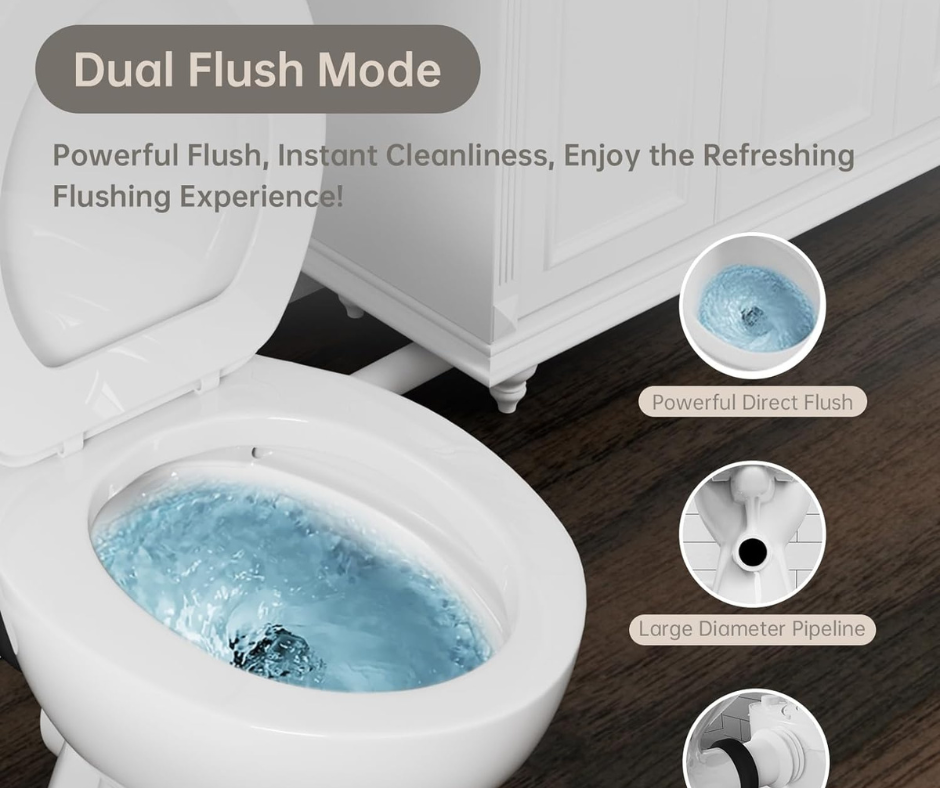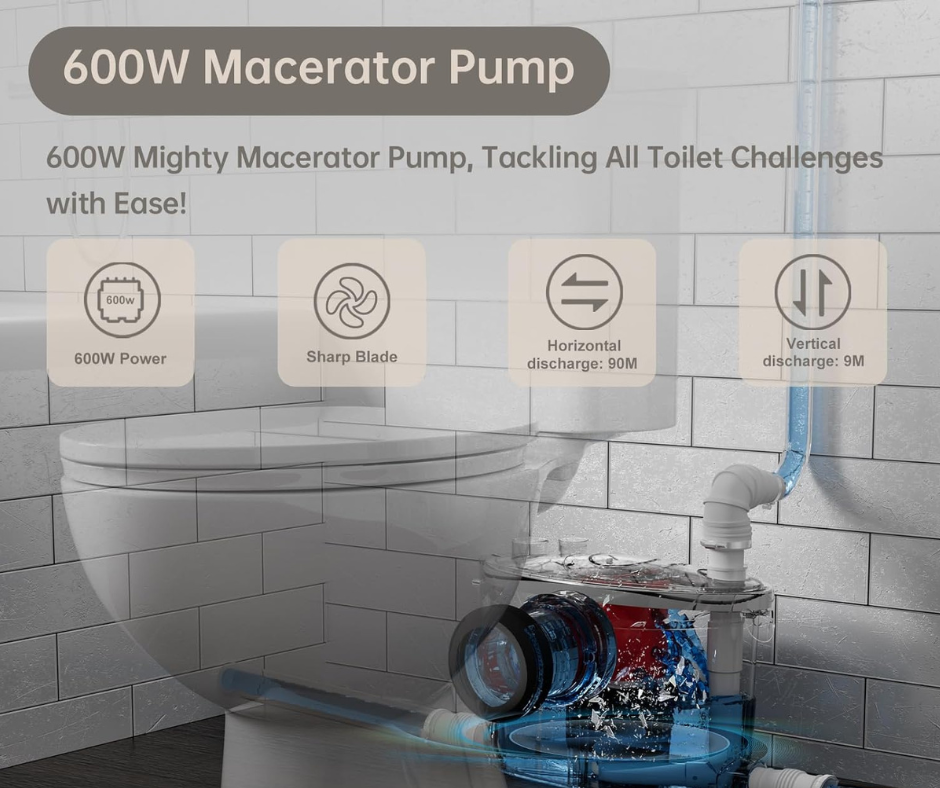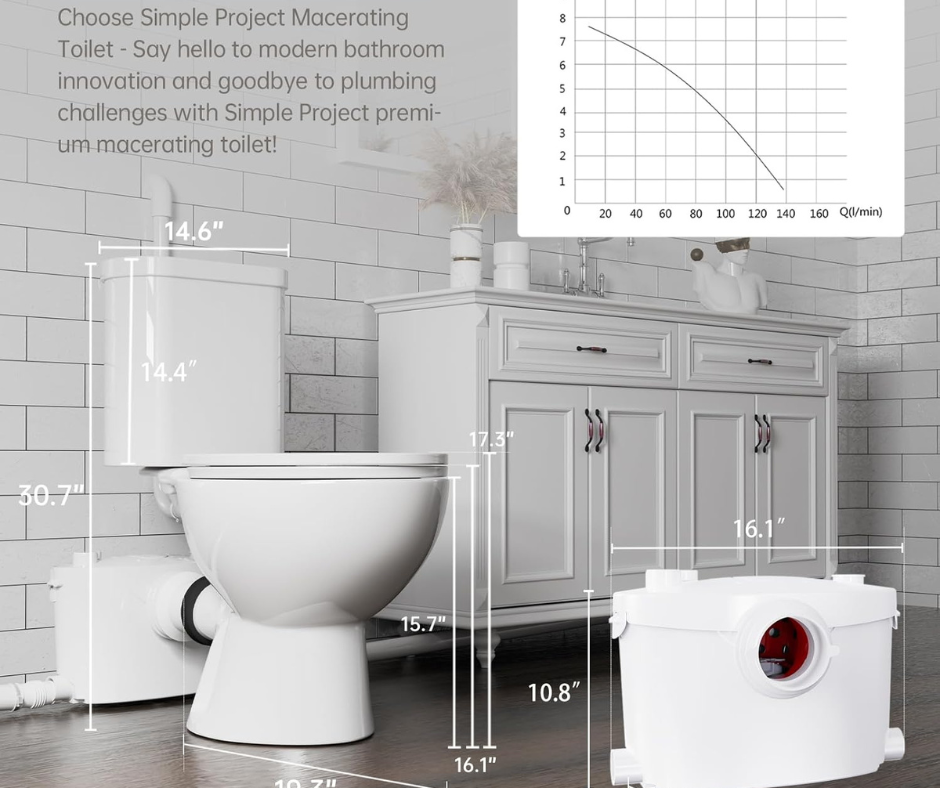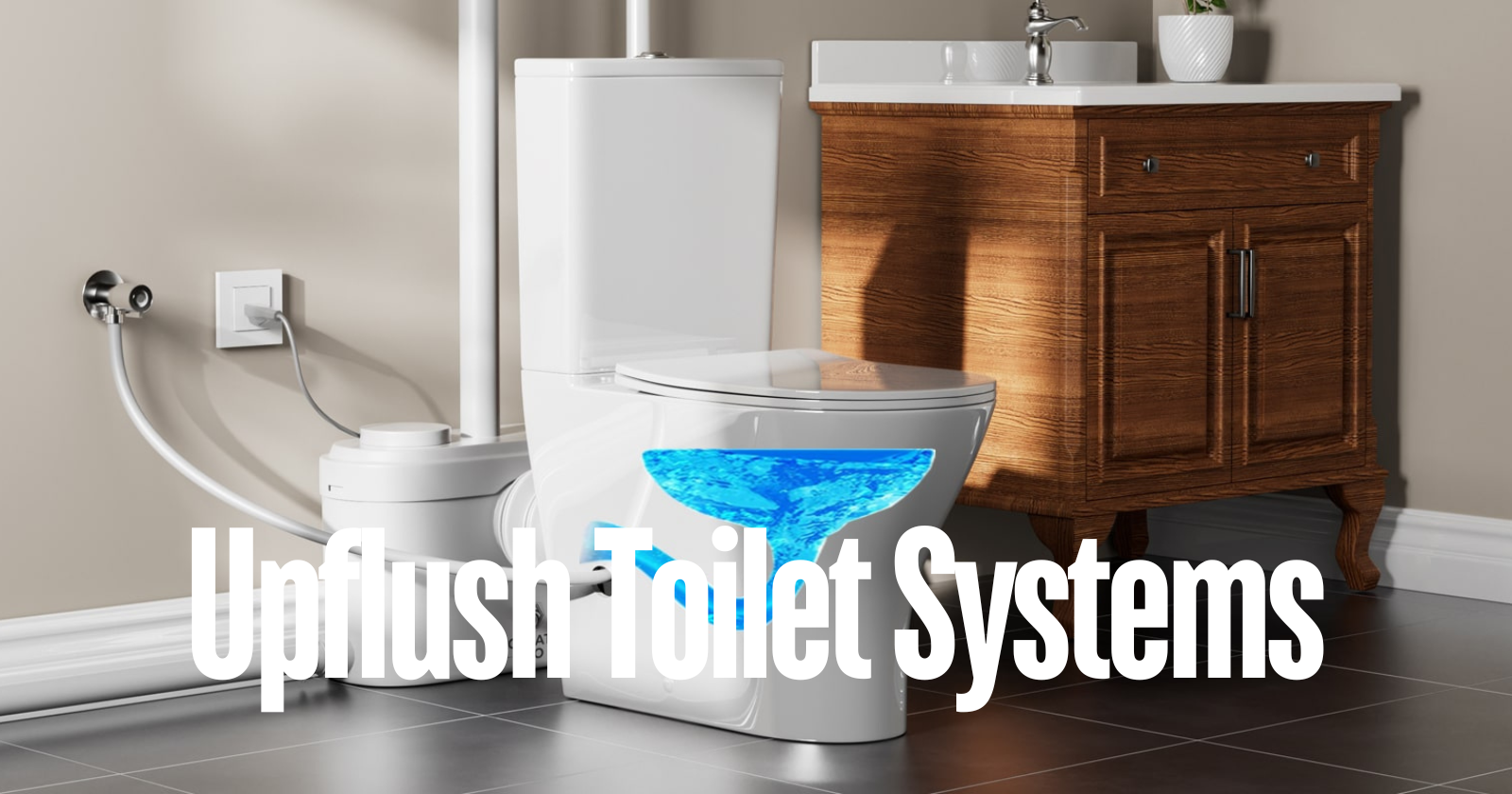Upflush Toilet Systems
Upflush toilet systems provide an innovative solution for installing a bathroom in a space where traditional plumbing isn’t feasible.
Designed to work with existing plumbing and elevate the waste to a level where it can be easily directed to the main sewer line, upflush toilets are ideal for basement bathrooms, attic conversions, and any area where gravity-based plumbing might be impractical.
In this guide, we’ll delve into the functionality of upflush toilet systems, their advantages, and how they can transform otherwise unusable spaces into functional, comfortable bathrooms.

Understanding Upflush Toilet Systems
Upflush toilet systems offer a smart solution for adding bathrooms in challenging locations. These systems use special technology to move waste upward and away from the toilet.
Defining Upflush Toilets
An up-flush toilet pumps waste upward. It’s also known as a macerating toilet or pressure-assisted toilet.
Upflush toilets look similar to regular toilets. The main difference is a small pump unit behind or near the toilet.
These toilets are great for spaces where normal plumbing is hard to install. They work well in basements, garages, and other tricky spots.
How Upflush Toilets Work
Upflush toilets use a macerator and pump system to handle waste. Here’s how it works:
- When you flush, waste goes into the macerator.
- The macerator grinds the waste into a fine slurry.
- The pump moves this slurry up through small pipes.
- The waste then joins the main plumbing line.
This process allows the toilet to move waste upward or over long distances, unlike regular toilets, which rely on gravity to move waste down.
Benefits of Upflush Toilet Systems
Upflush toilets offer several key benefits:
- Flexibility: We can add bathrooms anywhere, even far from the main plumbing lines.
- Cost-effectiveness: They often cost less to install than traditional plumbing.
- Easy installation: No need to break concrete or do major renovations.
- Compact: The small pipes take up less space than standard plumbing.
These systems are great for home additions, basement renovations, and guest bathroom additions. They make improving a home’s value and functionality easy without big, costly projects.

Components and Installation
Upflush toilet systems have several essential parts and can be installed differently. Let’s examine what makes up these systems and how to set them up.
Key Components
The main parts of an upflush toilet are the bowl, tank, macerator, pump, and drain pipe. The bowl and tank look like a regular toilet. The macerator grinds waste into a fine slurry.
The pump moves this mix through pipes. A holding tank briefly stores waste. The discharge pipe takes waste to the main sewer line. Venting helps the system work well.
Some systems need an extension pipe to reach the sewer. These parts work together to move waste up and out.
The Installation Process
We start by finding the right spot for the toilet. It must be near power and have a clear path to the sewer line.
Next, we set up the toilet’s base and connected the macerator and pump.
After that, we run the discharge pipe to the sewer line and install venting to prevent air locks.
Finally, we hooked up the water supply and tested the system. For someone with experience, the whole process can take about 4 hours.
Professional Installation vs. DIY
Many people can install an upflush toilet themselves. The systems are made to be easy to install, and you don’t need special tools or plumbing skills.
But some might prefer a pro. A plumber can make sure everything is set up right. They know local codes and can spot potential issues.
DIY can save money. It’s a good choice if you’re handy and have time.
Pro install costs more but can give peace of mind. It’s best for complex setups or if you’re uncomfortable with plumbing work.

Design Features and Specifications
Upflush toilet systems have unique design elements that set them apart from standard toilets. These systems use advanced technology to move waste upwards against gravity.
Innovative Design Aspects
Upflush toilets have a special macerating unit built into the base. This unit grinds waste into a fine slurry, which can then be pumped through small pipes to the main sewage line.
Many models have a sleek, modern look. The D-shaped toilet seat is a popular choice. It gives a clean, streamlined appearance.
The toilet bowl is often smaller than standard toilets. This helps the unit fit in tight spaces.
Some models hide the macerating pump inside the toilet. Others have a separate unit behind the toilet. Both types work well, but the hidden pump gives a neater look.
Technological Advancements
Upflush systems use powerful motors to move waste.
The Saniflo SaniPLUS has a 1 HP motor that can pump waste up to 15 feet high and move it horizontally up to 150 feet.
Many models have built-in alarms—these alert users to any issues with the system.
Some even have automatic shut-off features to prevent overflow.
New models are quieter than ever. They use sound-dampening technology to reduce noise, making them more pleasant to use, especially in small spaces.
Comparing Dimensions and Size
Upflush toilets come in various sizes to fit different spaces. Here’s a quick comparison of some popular models:
| Model | Height | Width | Depth |
|---|---|---|---|
| SaniACCESS 3 | 18.5″ | 14.5″ | 21.5″ |
| SaniBEST Pro | 20″ | 18″ | 26″ |
| SaniCOMPACT | 18.5″ | 14.5″ | 21.5″ |
The SaniCOMPACT is one of the smallest options. It’s great for tight spaces like under-stairs and bathrooms.
The SaniBEST Pro is larger but offers more power for multiple fixtures.
We find that most upflush toilets are shorter than standard toilets. This can make them more comfortable for some users. It also helps them fit under low ceilings.

Performance and Efficiency
Upflush toilet systems offer strong performance and efficiency. They use special technology to handle waste and save water.
Efficiency Metrics
Upflush toilets are very efficient. Many models use only 1.28 gallons per flush (gpf), saving much water. Some older types might use 1.6 gpf, but this is still less than old regular toilets.
We’ve found that these toilets can flush well even with less water. The macerating pump helps break down waste, so it flushes away easily.
Upflush systems also save space. Unlike normal toilets, they don’t need big pipes, making them great for small bathrooms or basements.
Power and Motor Details
The heart of an upflush toilet is its motor. Most use a ½ hp motor. This gives enough power to move waste up and away.
These motors usually run on 115 or 110 volts, the same as most home outlets, so they’re easy to plug in.
The Saniflo SaniPLUS and Saniflo SaniBEST Pro are popular models. Their strong motors can push waste up to 15 feet high and 150 feet away.
Water Usage and Conservation
Upflush toilets are great for water conservation. They use much less water than old toilets.
A typical upflush toilet uses 1.28 to 1.6 gpf. This is way less than the 3.5 to 7 gallons that very old toilets use.
We’ve seen that these toilets can save thousands of gallons of water each year. This is good for the planet and can lower water bills, too.
Some models have two flush options. This lets you use even less water for liquid waste.

Maintenance and Troubleshooting
Upflush toilets need regular care to work well. We’ll cover key practices to keep your system running smoothly and how to fix common problems.
Routine Maintenance Practices
We recommend cleaning your upflush toilet weekly. Use non-acid cleaners to avoid damaging the pump.
Then, pour 1-2.5 liters of toilet cleaner into the bowl and let it sit for 2 hours before flushing.
Check the macerator every few months. Look for any buildup or debris. Clean it if needed.
Inspect connections and pipes yearly. Look for leaks or loose fittings. Tighten or replace parts as needed.
Test the alarm system regularly. Make sure it works to alert you of issues.
Finally, don’t flush items that can clog the system. Stick to toilet paper and human waste only.
Identifying Common Issues
Bad smells often mean a problem. This could be due to poor cleaning or a clog.
Leaks can occur around the base or in pipes. Look for water where it shouldn’t be.
Gurgling sounds might mean a clog or air in the lines.
Slow flushing could indicate a partial blockage or pump issue.
If the toilet keeps running, the float switch might be stuck.
A non-flushing toilet could mean a power issue or pump failure.
Troubleshooting Tips
For clogs, try plunging first. If that fails, you may need to check the macerator for blockages.
No power? Check the circuit breaker and reset it if needed.
Bad smells? Clean thoroughly and check for proper venting.
Leaks need quick action. Turn off water and power, then find and fix the source.
For pump issues, consult the manual. You might need to clean or replace parts.
If problems persist, call a pro. Some repairs need special tools or knowledge.

Cost and Considerations
Upflush toilet systems offer unique benefits but come with specific cost factors and long-term considerations. Let’s explore the key aspects to remember when deciding if this option is right for you.
Pricing and Value
Upflush toilets are more expensive than standard toilets. Prices typically range from $600 to $1,500 for the unit alone. Due to simpler plumbing requirements, installation costs vary but are often lower than traditional toilets.
We’ve found that these systems can be a convenient and affordable option for adding bathrooms in basements or other locations without existing plumbing. The value comes from avoiding major construction costs.
Some key pricing factors:
- Brand and model
- Pump power
- Additional features (e.g., heated seats)
While the upfront cost is higher, the long-term savings on remodeling can make upflush toilets an economical choice in many situations.
Long-Term Durability
Upflush toilets are designed to be durable, but their lifespan can vary based on usage and maintenance. With proper care, most quality systems last 10-15 years.
Key durability factors:
- Pump quality
- Macerator blade materials
- Frequency of use
Regular cleaning and following manufacturer guidelines can extend the life of your upflush system.
Avoid using harsh chemicals that could damage internal components.
These systems may require more frequent maintenance than traditional toilets. Keeping spare parts on hand can minimize downtime if issues arise.
Warranty and Support
Most upflush toilet manufacturers offer warranties ranging from 2 to 5 years. Some premium brands may provide longer coverage. We always advise checking warranty terms before purchasing.
Typical warranty coverage includes:
- Defects in materials
- Workmanship issues
- Pump failures
Many brands offer customer support for installation guidance and troubleshooting. This can be valuable for DIY installations or addressing minor issues.
Choose a reputable brand with a strong track record of customer service. Look for companies that provide detailed manuals, video tutorials, and responsive support channels.
Remember to register your product after purchase to ensure full warranty coverage. Keep all documentation in case you need to claim in the future.
Wrapping Up
Upflush toilet systems offer a versatile and efficient solution for adding a bathroom to areas where conventional plumbing might be challenging.
These systems use advanced technology to pump waste and water to the main sewer line, making it possible to create functional bathrooms in spaces previously deemed unsuitable.
With their ease of installation, minimal disruption, and ability to adapt to various setups, upflush toilets are a smart choice for many homeowners and renovators.
Whether enhancing an existing space or undertaking a new project, upflush toilet systems provide the flexibility and convenience needed to make your bathroom dreams a reality.


